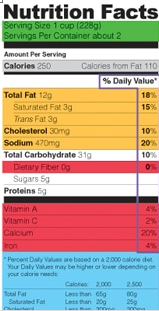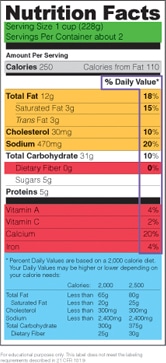 Nutrition Facts Labels 101
Nutrition Facts Labels 101
Serving Size
The first item you want to determine from a nutrition facts label is how big is a serving size. Everything else on the label is based on a single serving size. So if a food package contains fours servings and you eat two servings you need to double everything on the label to know how many calories, grams of fats, carbohydrates, and fats you consumed.
Serving size for the nutrition label below is 1 cup and there are 2 servings in the container. If you consumed two servings you will have eaten 500 calories.
A serving size is not necessarily the same as a portion size. Portion sizes are different for adults than they are kids. Two servings may be an appropriate portion size for an adult while one may be an appropriate portion size for a kid.
Percent Daily Value
 On the nutrition facts labels you will find % Daily Value. The daily value percentages are based on 2,000 calories a day. You daily calorie requirement may be more or less.
On the nutrition facts labels you will find % Daily Value. The daily value percentages are based on 2,000 calories a day. You daily calorie requirement may be more or less.
Let’s use the label to the right. If you eat one serving and you require 2,000 calories a day you will receive 18% of you total fat requirements. But, if you require 2,500 calories then one serving provides 14% of your daily requirement of fat or (2,000/2500) x 18 = 14.4%
Calories
Fats provide roughly 9 calories per gram while carbohydrates and proteins each provide 4 calories per gram. Just knowing that you can calculate the calories per serving coming from fat, protein, and carbohydrates, though the nutrition facts labels will do the math for you when it comes to fats.
On the label shown there are 110 calories from fat (gray area) and 12 grams of fat (yellow area) in one serving (or 12 grams of fat multiply by 9 calories per gram = 108 (close enough to 110). It’s widely recommended that no more than 30% of your daily calories come from fat sources.
- 40 calories per serving is considered low.
- 100 calories per serving is considered moderate.
- 400 + calories per serving is considered high.
“Low fat” or “low in sugar” does not necessarily mean low in calories. Read the nutrition facts label for the details.
Dietary Fiber and Sugar
Pay close attention to the amount of fiber and sugar per serving. Fiber is good, sugar is bad. You want to consume 25 to 30 grams of fiber a day (most Americans only get 10 to 15 grams/daily).
Keep your daily consumption of sugars to as low as possible. The American Heart Association (AHA) recommends that women consume no more than 100 calories from sugar a day, or 25 grams of sugar. For men no more than 150 calories from sugar are recommended or 37 grams a sugar. When shopping for cereals, for instance, look for cereals with less than 10 grams of sugar per serving. A serving of plain yogurt typically has 10 grams of sugar while fruit yogurt may have over 40 grams of sugar.
Trans Fats
Trans fats raise unhealthy LDL cholesterol and make cell membranes more rigid hampering with hormone function and transport of nutrients across the cell wall. Ideally, you should consume no trans fats. By law if a food serving contains less than 0.5 grams of trans fat the label can say that it contains zero trans fats. Trans fats are found in snack foods, fast food, pizza, vegetable shortenings, refrigerated dough products, cookies, crackers, and baked goods.
Ingredients
A list of ingredients is usually available at the very bottom of a nutrition facts label. Ingredients are listed in order of abundance. The most abundant ingredient is listed first. Become familiar with the many names of sugar as you read the list of ingredients.
